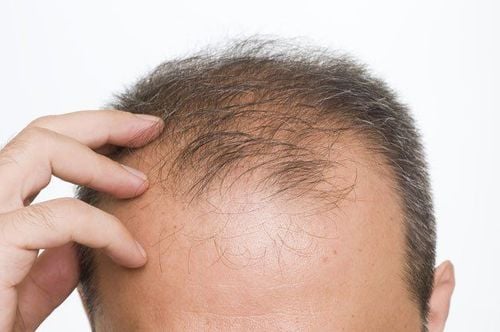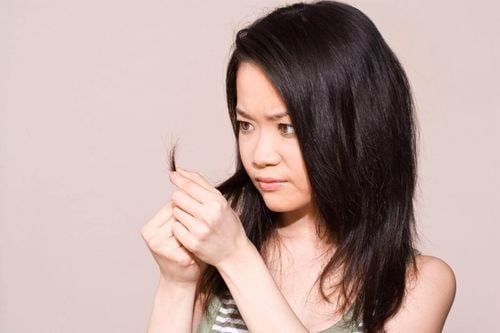This is an automatically translated article.
Telogen alopecia is a common hair loss condition, usually occurring after a person experiences sudden physical trauma, affecting the growth of hair follicles. This can cause your hair to fall out a lot over a certain period of time. Early treatment will help you regain your normal healthy hair.
1.What is Telogen Hair Loss?
Telogen alopecia (telogen effluvium – TE) is the second most common form of hair loss diagnosed by dermatologists. This hair loss occurs when there is a change in the number of hair follicles that are growing into hair.
Normally, the hair follicles on the scalp do not continuously produce hair. They are in a growth phase that can last for up to 2 years or more, then go into a resting phase for up to 2 months before starting to regrow new hairs. At any given time, for a person with a healthy scalp, about 80-90% of the hair follicles are developing normally into hair. These active follicles are in the Anagen phase. Meanwhile, about 10-20% of the hair follicles on the scalp are in a resting state (Telogen), meaning they do not produce any hair.
If the number of hair follicles that make hair is significantly reduced during the resting (telogen) phase, there will be more dormant hair follicles. This can lead to telogen hair loss (TE).
Telogen alopecia usually presents with a diffuse thinning of hair on the scalp. It can become more severe in certain areas of the scalp. Normally, the hair on the top of the scalp tends to be thinner than the hair on the sides or back of the scalp.
The hairs that fall out are usually telogen filaments, which can be identified by the small horny bulbs at the tips of the hair roots. Whether keratogenic tumors are pigmented or non-pigmented, these hairs are typical telogen filaments.
2. Symptoms of Telogen Hair Loss (TE)
Initially, telogen alopecia (telogen effluvium) appears as thinning hair in some areas or all over the scalp. In general, the top of the scalp is the most affected area. Rarely, TE causes your hairline to recede at the nape of your neck or lose all of your hair.
Although people with telogen alopecia (TE) do not lose all of the hair on their scalp, the amount of hair can be significantly thinner in some severe cases. For severe TE, it can affect areas other than the scalp, such as the pubic area or the eyebrows.

Rụng tóc Telogen xuất hiện dưới dạng tóc mỏng ở một số khu vực hoặc khắp nơi trên da đầu
3. How does Telogen hair loss develop?
Telogen alopecia (TE) usually develops in 3 ways:
First form of TE
Environmental trauma can "shock" growing hair follicles to the point that they decide to go into a state. rest for a while. This causes your hair to fall out more and thinning areas spread across the scalp. This form of telogen hair loss tends to grow rapidly and becomes apparent only 1-2 months after the hair follicles are affected. If this stimulation is short-lived, the hair follicles will return to normal growth and begin to produce new hairs fairly quickly. This form of TE usually lasts less than 6 months and affected individuals will have normal scalp hair density within a year.
Second form of TE
This telogen alopecia usually develops more slowly but lasts longer. Your hair will not fall out suddenly, nor will it go into the resting state of Telogen. Instead, the hair follicles can go into a normal resting state, but then they don't return to a new anagen hair growth state after 1-2 months but stay in a long Telogen phase.
This has resulted in a gradual accumulation of hair follicles in the Telogen state and fewer and fewer growing anagen hair follicles. In this form of TE, your hair loss is not severe, but it will thin out over time. This telogen alopecia is more likely to occur in response to some persistent and persistent trigger.
The third form of TE
The hair follicles are not in a resting state but in a shortened growth cycle. At that time, you will feel the scalp becomes thin and continuously lose short hairs.
4. Causes of Telogen Hair Loss
Telogen hair loss ( telogen effluvium ) can be triggered by many different factors, including:
Environment
Physical trauma, such as blood loss, car accident or surgery, both can cause telogen alopecia. In addition, exposure to toxic chemicals and heavy metals is also considered to be the main cause of this condition. The "shock" from the environmental change has caused the hair follicles to go into a resting state and not grow as normal. Once the environment is stable again, your hair can quickly grow back to normal.
Hormones
Experiencing sudden changes in hormones can cause telogen hair loss (TE). Similar to environmental changes, hormonal fluctuations in the body are also considered to be the main cause of hair follicles going into a prolonged resting state. If TE occurs during pregnancy, your hair will regain growth within 6 months to a year after giving birth.
Medication use or medical treatment
Certain antidepressants, birth control pills or blood pressure medications can cause telogen hair loss. Before starting a new medication, you should consult with your doctor to determine if it is causing TE or to recommend a different medication that is more suitable.
Also, getting vaccinations or doing some surgery can also cause a “shock” to your hair follicles and put them to rest. However, your hair should grow back to normal within a few months.
Diet
Some studies suggest that telogen hair loss can be the result of a deficiency in vitamins or other nutrients, including:
Vitamin B6 Vitamin B12 Zinc Iron Ideally, you should give Talk to a nutritionist to build your own healthy diet. In addition, you should also avoid extreme dieting as it can contribute to telogen hair loss.

Chế độ ăn uống thiếu sắt có thể dẫn đến rụng tóc Telogen
5. Is hair loss another serious health problem?
Sometimes hair loss can be a sign of another medical condition. For example, alopecia areata is an autoimmune condition of the body that leads to total hair loss. In addition, thyroid problems and abnormal fluctuations in thyroid hormones can also cause hair loss. On the other hand, allergic contact dermatitis to hair dye is also considered another factor leading to hair loss.
6. Telogen Hair Loss Treatments
Treatments for telogen hair loss (TE) often include lifestyle changes combined with the use of over-the-counter (OTC) medications. The best way to treat this hair loss is to find out the main cause of it, including the environment, hormones or your daily lifestyle.
Here are the methods to help you effectively treat Telogen hair loss:
Adopt a healthy diet
Deficiencies in vitamins and other essential nutrients can take a toll on your health of hair. You should see your doctor and determine if you should take a vitamin D, iron, or zinc supplement. Overall, eating a well-balanced diet is extremely important, helping you get all the nutrients your body needs and support healthy hair growth.
Proper hair care
If you have Telogen alopecia, you should be very gentle when styling your hair. Avoid straightening, drying, or perming your hair until your TE improves. Regularly perming and dyeing your hair during TE will further damage your hair and inhibit hair growth.
Use OTC products
Some over-the-counter medications can help you grow your hair back, such as Minoxidil 5% – a once-daily topical product. This hair growth drug works by prolonging the Anagen phase of the hair follicles, allowing for more active hair growth.
Relax
If telogen hair loss is stress related, you should control and reduce your stress levels to improve the condition. Some methods help you relax your body, such as meditation, yoga, or exercise.
Please dial HOTLINE for more information or register for an appointment HERE. Download MyVinmec app to make appointments faster and to manage your bookings easily.
Reference source: healthline.com













